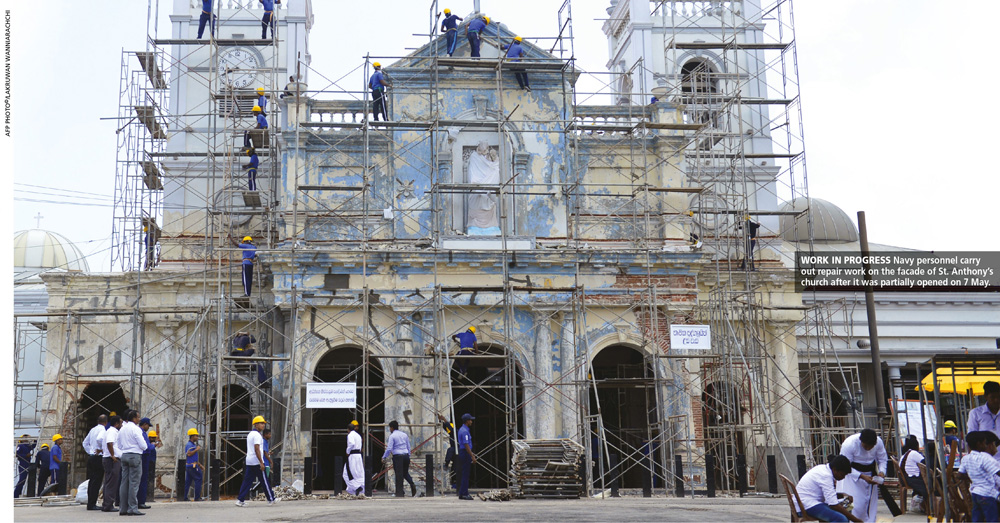EASTER SUNDAY AFTERMATH
BACK TO A WAR FOOTING
Amantha Perera takes note of the evolving scenario following the Easter Sunday attacks
Sri Lanka hardly rings a bell unless you’re travelling in the region. People will nod their heads… and talk about other matters. But as I travelled through East Asia a week after the Easter Sunday attacks, the reactions were different.
“Ah Sri Lanka! The bombs… very bad, very dangerous!” was the response from a cab driver in Jakarta. The island was in the news once again albeit for all the wrong reasons. Usually, after two attempts to pronounce my name, taxi drivers change the topic to Jakarta’s traffic.
Despite a ‘visa on arrival’ policy, all Sri Lankan passport holders who didn’t have visas stamped by the Indonesian embassy in Colombo were held back at immigration.
They were herded to a separate holding area where each traveller was rudely questioned as to why he or she was travelling to Indonesia. One young immigration officer even had a pair of handcuffs placed on the table.
The Easter Sunday attacks have resulted in the Sri Lankan passport being relegated to the bottom of the pile once more… similar to what happened during nearly 30 years of war. Visitors from countries like India and some Middle Eastern nations also suffered the same fate.
Although the authorities had been warned about the attacks, the public were taken by surprise. And the bombings sent shock waves across the island as well as abroad. A friend who had travelled to our once war-torn republic mused: “Why is this country destined to be doomed when it had so much promise?”
It’s a question that many of us are still struggling to answer, 10 years after the war ended.
The attacks have clearly stifled the momentum that the hospitality sector had gained in recent times; it was thriving despite the government’s lacklustre leadership.
In the weeks that followed Easter Sunday, the Bandaranaike International Airport (BIA) was a mess – a smooth and uncluttered mess. No vehicles were allowed into the departure terminal. Travellers were asked to alight about 100 metres away and walk with their baggage. This isn’t a major inconvenience unless it rains.
Outsiders weren’t allowed in the departure area other than those with valid tickets. This makes it very easy to navigate; few people, fewer issues and no more elderly ladies saying goodbye to half their families. Security has been tight – probably the tightest since 2009 and reminiscent of what we saw after the July 2001 attack on the airport.
When I travelled about a month before the attacks, the area was bustling with backpackers, a tour group from Myanmar, sundry tourists and Sri Lankan travellers. This time, it was half empty.
The arrivals hall was the same; perhaps a little more crowded. No vehicles were allowed near the terminal. All pickups were directed to Minuwangoda Road. Only airport taxis were allowed near the terminal and taxi drivers complained that even Sri Lankans were choosing to use privately hired vehicles.
Unlike when the LTTE launched attacks against the state, Sri Lanka is now a changed place. Social media has made it possible for travellers to obtain information, and hear rumours and falsehoods when they bypass established media channels. A few days after the extensive countrywide search operations began, the government appealed to the public not to divulge details of ongoing investigations on social media.
People will take time to get back to their laid-back travel trends. On top of this, the enemy is far more obscure and violent with a wider scope of possible targets. In other words, anyone who doesn’t subscribe to the hardcore and archaic values of the attackers may be targeted.
Even at the worst of times during the long-drawn-out civil war, neither Colombo nor the rest of the island shut down in the manner it did during the days and weeks following the 21 April attacks.
There is also concern about the nature of the ideology that motivated the attackers. ISIS cells can and have operated with minimal links (sometimes without any links too) to its main command structure, leading to attacks that are spontaneously influenced rather than command centric.
Based on how Da’ish has operated in Europe, there are fears that the Easter Sunday attacks could be the harbinger of a shift in battleground to Asia where security is lax.
All in all, the attacks have changed the political and security dynamics of the region. Given how the terrorists have sprung up and the background of some of the bombers, the level of suspicion has reached unimaginable proportions.
The end of the war offered Sri Lanka a chance to forge a national identity that isn’t reliant on race or religion. But that was squandered. Instead of a new Sri Lankan identity, politicians from both the majority and minority communities who were looking for votes made racial fault lines more pronounced.
Ten years after the armed conflict ended, Sri Lanka is confronted once more with a scenario of mass national angst and neighbourly suspicion.
The economy will recover in time but Sri Lankans must ask themselves whether they want to be inveigled into this divisive political play once again. To expect such leadership to come from within the traditional political parties is a lost cause.
Change needs to come from the social fabric with each one of us taking a public stand on the needs of the hour – but that doesn’t seem likely at this time.






Until we have a new set of politicians, there will be many wars because they play games to stay in power.
I think we have been on a war footing since 1959, when the Sinhala Only Act was passed.